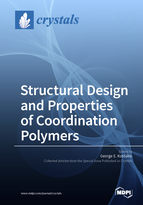Structural Design and Properties of Coordination Polymers
A special issue of Crystals (ISSN 2073-4352). This special issue belongs to the section "Macromolecular Crystals".
Deadline for manuscript submissions: closed (20 November 2017) | Viewed by 54495
Special Issue Editor
Special Issue Information
Dear Celleagues,
The assembly of organic ligands and metal centres yields coordination polymers, many of which find applications in conductivity, catalysis, magnetism, gas sorption, biological sensing and luminescence. The structure and topology of coordination polymers may be manipulated by changing the reaction conditions, leading to a large variety of structurally and topologically unique products. However, controlling and predicting the final outcome of the self-assembly procedure remains one of the major challenges in the field. The final products are often strongly influenced by factors such as the behaviour of a functional group in a molecule, the influence of the crystallization conditions and the various conformations of the components within the crystal.
This Special Issue aims to cover a broad range of subjects in coordination polymer chemistry, which are important to the continued growth of the field, showcase current developments and realise its full potential in applications to address major societal challenges.
Therefore, we invite you to contribute a research article to this Special Issue and provide a clear snapshot of your research in this field.
Dr. George E. Kostakis
Guest Editor
Manuscript Submission Information
Manuscripts should be submitted online at www.mdpi.com by registering and logging in to this website. Once you are registered, click here to go to the submission form. Manuscripts can be submitted until the deadline. All submissions that pass pre-check are peer-reviewed. Accepted papers will be published continuously in the journal (as soon as accepted) and will be listed together on the special issue website. Research articles, review articles as well as short communications are invited. For planned papers, a title and short abstract (about 100 words) can be sent to the Editorial Office for announcement on this website.
Submitted manuscripts should not have been published previously, nor be under consideration for publication elsewhere (except conference proceedings papers). All manuscripts are thoroughly refereed through a single-blind peer-review process. A guide for authors and other relevant information for submission of manuscripts is available on the Instructions for Authors page. Crystals is an international peer-reviewed open access monthly journal published by MDPI.
Please visit the Instructions for Authors page before submitting a manuscript. The Article Processing Charge (APC) for publication in this open access journal is 2600 CHF (Swiss Francs). Submitted papers should be well formatted and use good English. Authors may use MDPI's English editing service prior to publication or during author revisions.
Keywords
-
Structural Design and Topological studies
-
Catalysis
-
Health and medical applications
-
Electronic and magnetic properties






